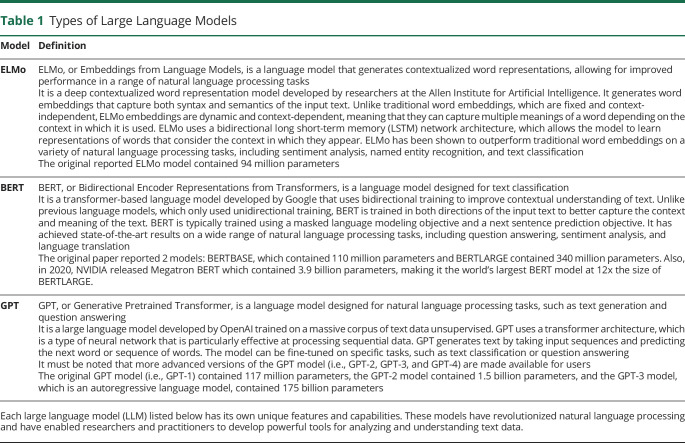Table 1.
Types of Large Language Models
| Model | Definition |
| ELMo | ELMo, or Embeddings from Language Models, is a language model that generates contextualized word representations, allowing for improved performance in a range of natural language processing tasks It is a deep contextualized word representation model developed by researchers at the Allen Institute for Artificial Intelligence. It generates word embeddings that capture both syntax and semantics of the input text. Unlike traditional word embeddings, which are fixed and context-independent, ELMo embeddings are dynamic and context-dependent, meaning that they can capture multiple meanings of a word depending on the context in which it is used. ELMo uses a bidirectional long short-term memory (LSTM) network architecture, which allows the model to learn representations of words that consider the context in which they appear. ELMo has been shown to outperform traditional word embeddings on a variety of natural language processing tasks, including sentiment analysis, named entity recognition, and text classification The original reported ELMo model contained 94 million parameters |
| BERT | BERT, or Bidirectional Encoder Representations from Transformers, is a language model designed for text classification It is a transformer-based language model developed by Google that uses bidirectional training to improve contextual understanding of text. Unlike previous language models, which only used unidirectional training, BERT is trained in both directions of the input text to better capture the context and meaning of the text. BERT is typically trained using a masked language modeling objective and a next sentence prediction objective. It has achieved state-of-the-art results on a wide range of natural language processing tasks, including question answering, sentiment analysis, and language translation The original paper reported 2 models: BERTBASE, which contained 110 million parameters and BERTLARGE contained 340 million parameters. Also, in 2020, NVIDIA released Megatron BERT which contained 3.9 billion parameters, making it the world's largest BERT model at 12x the size of BERTLARGE. |
| GPT | GPT, or Generative Pretrained Transformer, is a language model designed for natural language processing tasks, such as text generation and question answering It is a large language model developed by OpenAI trained on a massive corpus of text data unsupervised. GPT uses a transformer architecture, which is a type of neural network that is particularly effective at processing sequential data. GPT generates text by taking input sequences and predicting the next word or sequence of words. The model can be fine-tuned on specific tasks, such as text classification or question answering It must be noted that more advanced versions of the GPT model (i.e., GPT-2, GPT-3, and GPT-4) are made available for users The original GPT model (i.e., GPT-1) contained 117 million parameters, the GPT-2 model contained 1.5 billion parameters, and the GPT-3 model, which is an autoregressive language model, contained 175 billion parameters |
Each large language model (LLM) listed below has its own unique features and capabilities. These models have revolutionized natural language processing and have enabled researchers and practitioners to develop powerful tools for analyzing and understanding text data.

